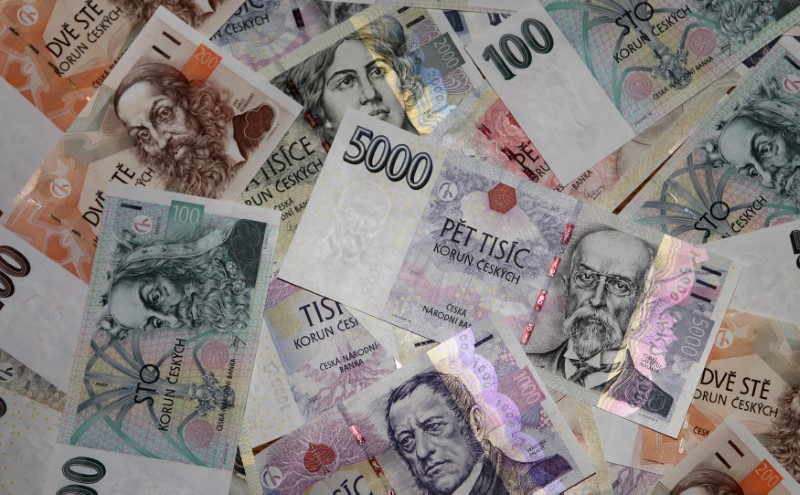By Marc Jones and Jan Lopatka
LONDON/PRAGUE (Reuters) - As Czech policymakers get closer to removing their cap on the value of the country's currency, the crown, forwards markets have started pricing in a Swiss franc-style sudden jump, albeit with not quite so dramatic consequences.
Recent remarks by the new head of the Czech central bank about not needing inflation to be exactly at target to remove the cap have seen a rush of bets
One commercial bank has called the short euro/crown forward the "trade of 2017", saying the cap could go before March next year. Analysts estimate the upward jolt in the crown will be anywhere from 2.5 percent to 10 percent.
That could hurt a small, open economy like the Czech Republic's, although it would be nowhere near the 40 percent surge by the Swiss franc in January 2015, when the Swiss National Bank eliminated its euro cap without warning in what became known as "Frankenshock".
"It is very difficult to say with any confidence what the move will be when the floor is lifted, but if I were to give a very rough estimate it would be in the range of 3 to 4 percent," said Deutsche Bank (DE:DBKGn) strategist Gautam Kalani.
"I think it is different (to Switzerland), as the Swiss franc faces massive global safe-haven inflows, a dynamic that isn't there for the Czech crown."
It is not usually possible to predict the scale of a move using forwards markets, but the crown's cap makes it easier. The further the forward goes from the central bank's limit - 27 crowns to the euro - the more the crown is expected to jump.
The crown (EURCZK=) was as high as 25.5 per euro before the cap was introduced in late 2013. Returning to that level would be a rise of more than 9 percent, although the central bank has said it won't allow that.
Another option is to calculate the real effective exchange rate (REER), which is the weighted average of a currency against a basket of its main peers, adjusted for inflation. (Graphic click http://link.reuters.com/vuf47v)
The crown's current REER is 5 percent below its 10-year average, which if flipped is the upper limit of a post-cap rise that banks such as JPMorgan (NYSE:JPM) predict.
"There is a range of reasonable target levels, perhaps from 25.8-26.3 (crowns per euro), in our view, depending on the circumstances at the time of the exit," its analysts, Anezka Christovova and Saad Siddiqui, said in a note.
"EXPLODE IN YOUR FACE"
The prospect of a leap in the crown makes Czech bonds and stocks potentially interesting for international investors. Their value would effectively rise when translated back into dollars or euros.
Prague's small stock market (PX) has underperformed in central and eastern Europe (MIME00000PUS) over the last year and interest rates of close to zero mean its government bonds (CZ10YT=RR) have had little attraction for yield hunters.
For some, that makes the currency move an all-or-nothing bet.
"It is an FX play, but it is not a very attractive FX play because it can explode in your face," Aberdeen Asset Management portfolio manager Viktor Szabo said, referring to the chance the cap's removal is delayed.
For those willing to take the punt, though, timing is key.
Central bank Governor Jiri Rusnok, who sparked the recent market moves with his inflation comments, has reiterated the plan remains for a mid-2017 move. That caused forwards to retreat a bit.
The counter argument is that the bank will need to surprise the market to avoid momentum building behind the crown. Large-scale - and costly - FX market intervention would then be needed to weaken the currency.
"Trade of 2017" exponents ING and JPMorgan both see the cap ending before mid-2017 for that reason. The central bank has already bought 20 billion euros since it started intervening in 2013, interventions that became more frequent this year.
But even with all the euros it has been buying, its foreign exchange reserves were just above 40 percent of gross domestic product in July - less than half of Switzerland's at the time of Frankenshock.
The head of the central bank's policy department, Tomas Holub, has also played down similarities to Switzerland.

He said the mixed messages on the timing of the cap's withdrawal was "certainly not" driven by a wish to have room for a "surprise exit a la Switzerland". "Do not look for any conspiracy," he said.